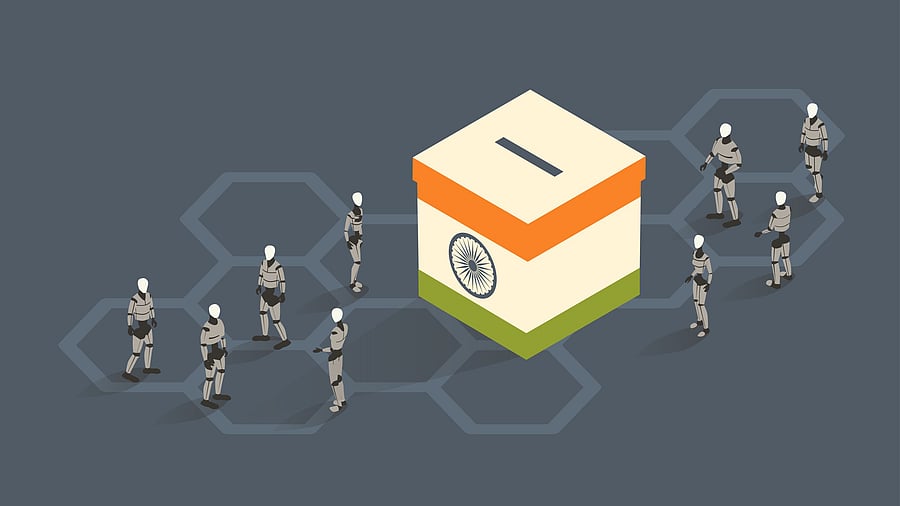
Image for representation.
Credit: iStock Photo
[Scene: A bustling office in South Block. Policy-Sir, the smart bureaucrat, adjusts his tie as Minister-Saar enters, holding a sheaf of papers with ‘AI Boss’ scribbled in bold.]
Minister-Saar: P-S, what’s this talk about an ‘AI Czar’? The Americans have one now. Don-Ald has announced it, no less. Should we consider one for India?
Policy-Sir: (smiling knowingly) Saar, the concept is, shall we say, both visionary and catastrophic.
Minister-Saar: Why catastrophic?
Policy-Sir: Because appointing an ‘AI Boss’ would create what we call a ‘highly combustible conundrum’. On one hand, it signals progress. On the other, it invites chaos. Who, after all, would take this job? Someone retired and influential looking for a sinecure? Or perhaps a tech-guru or industrial-garu whose friends’ offices are waiting to profit from insider policies?
Minister-Saar: So, you’re saying we shouldn’t do it?
Policy-Sir: (leaning forward conspiratorially) On the contrary, Saar, we absolutely must do it — just very, very carefully.
Challenges of the AI Boss role
Policy-Sir: AI is not merely another technology. It’s a transformative force shaping everything about society and humanity, and even our daily chai-drinking habits. The Americans aren’t appointing an ‘AI Czar’ for fun. They’re staking their claim to global supremacy in the digital age. Meanwhile, we are busy hosting grand conferences and delighting in visits from NVIDIA and OpenAI luminaries.
Minister-Saar: But those visits are good PR! They show India’s at the forefront of AI.
Policy-Sir: (raising an eyebrow) Or perhaps they highlight our role as a consumer market rather than an innovation hub. After all, the intellectual property — and the profits — reside firmly in the West. India is seen as a marvellous destination for consumption and cheap talent, not for leading-edge innovation, is it?
Minister-Saar: But if we’re to lead, surely we need a figure to bring it all together? Someone who can co-ordinate across ministries, states, and industries?
Policy-Sir: Ah yes, a unifying force. But this figure must possess the patience of a saint, the cunning of a fox, and the diplomatic skills of the United Nations Secretary-General. They’ll need to juggle priorities and points of negotiations across bureaucrats, academics, policymakers, industry titans, and even the judiciary. Imagine the chaos if they get it wrong: regulatory capture, stalled innovation, and fragmented policies.
Minister-Saar: So, we need a visionary?
Policy-Sir: Precisely, Saar. But a visionary with restraint. This role isn’t about innovation alone; it’s about governance — ensuring AI doesn’t reinforce societal inequalities or undermine democracy.
The stark reality
Policy-Sir: India’s AI ambitions are hindered by systemic inertia. While we revel in our demographic dividend, our education system — particularly in STEM — is woefully underfunded. Less than 2% of global AI patents come from India, and our universities are struggling to keep pace. If we don’t invest heavily in education and industrial research, our demographic advantage will quickly become a liability.
Minister-Saar: But surely, we’re doing something about this?
Policy-Sir: Oh, absolutely, Saar! We’ve done well with — ‘Digital India’. But unfortunately, ‘AI for all’ alone won’t build STEM ecosystems or world-class talent. Education, as you know, is a state subject. Without collaboration between the Union and states to modernise curriculums and strengthen STEM education, we’ll be left with catchy taglines but no real substance to back them up. After all, building an AI ecosystem without adequate vision is attempting to build and programme a computer without tools or electricity: ambitious, but ultimately futile!
The geopolitical stakes
Policy-Sir: Globally, the AI race is heating up. China is pumping billions into AI, while the European Union is busy crafting ethical frameworks. India, meanwhile, risks becoming a digital middleman — too underfunded to lead, too fragmented to collaborate.
Minister-Saar: So, what’s the solution?
Policy-Sir: A cohesive strategy, Saar. An ‘AI Boss’ could certainly unify our efforts, but they’d need to act with remarkable speed and decisiveness. They’d have to modernise education curriculums, foster interdisciplinary research, and ensure AI tools tackle India’s unique challenges — be it enhancing healthcare or boosting agricultural productivity. And let’s not forget, they’d also need to secure funding for the AI ecosystem, not just relying on government or private sector coffers but exploring innovative funding mechanisms to build a sustainable and robust framework. After all, innovation doesn’t fund itself!
Minister-Saar: P-S, you’re making this sound both essential and impossible.
Policy-Sir: Precisely, Saar. That’s the beauty of governance. Done well, it’s transformative. Done poorly, it’s disastrous. The real question is whether we’re prepared to invest — not just financially, but politically and intellectually — in creating an AI ecosystem that positions India as a leader.
[Closing Scene: The Minister leans back in his chair, pondering. Policy-Sir straightens his tie and prepares to leave.]
Minister-Saar: P-S, you’ve convinced me. Let’s draft the proposal. What shall we call it?
Policy-Sir: (smiling) Of course, Saar. Might I propose the title ‘PMAI: Prime Mover Advantage for India’. It always goes down well in press releases.
Minister-Saar: P-S, sometimes I think you’re the real ‘AI Boss’.
Policy-Sir: (grinning) Why thank you, Saar. Shall I have my office draft the announcement?
Voice-over (after the lights have dimmed): In India’s AI journey, the question isn’t whether we need a leader, but whether we have the clarity about the AI-future we wish to create.
(Srinath Sridharan is a policy researcher and corporate adviser. X: @ssmumbai.)
Disclaimer: The views expressed above are the author's own. They do not necessarily reflect the views of DH.